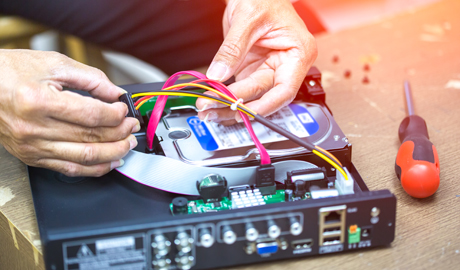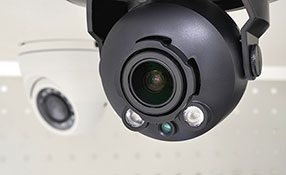 |
| One obvious benefit of an NVR appliance compared to software VMS system is ease of configuration and installation |
A quality networked video recorder (NVR) and software-based video management system (VMS) both do an excellent job of safeguarding valuable video data. But there are a number of pros and cons for both, along with specific applications that will do better with one option over the other. These can easily be broken down into five topics: ease of setup/install, support, scalability, usability and migration.
Ease of setup/install
One obvious benefit of an NVR appliance compared to software VMS system is ease of configuration and installation. Since there’s no software to install except for maybe a light client on a PC (and sometimes not even that), deploying an NVR system is faster and easier than the complexities that can occur when you install a VMS system on off-the-shelf servers and other hardware.
For smaller systems with fewer than 200 cameras, this reason alone is often why customers choose NVRs over VMS software. The tradeoff is that you have no choice but to buy the complete NVR solution. Considering hardware can be well over 60 percent of the cost of the solution, this might pin the customer into a corner for their overall budget, and can limit the future usability of the product.
Software solutions, on the other hand, benefit from being able to leverage existing hardware, or relatively cheaper commoditised hardware. This is especially true as system sizes scale. A 2,000-camera system, for example, would almost assuredly be less expensive in a software and commercial off-the-shelf (COTS) solution than it would to buy 10 200-channel NVRs. The tradeoff is that installation and setup are inherently more complex and takes longer on software and COTS then on a typical NVR system, though a lot of work has been done in the industry over the last few years to thin this gap considerably.
Support
When a customer buys an NVR, they’re buying everything from one manufacturer, with hardware that was hopefully designed and optimised specifically for that use. This means the solution is easier to support – including everything from installation assistance to troubleshooting problems. The warranty on an embedded solution is almost always better than a solution of software and COTS.
When a customer buys an NVR, |
If there’s a tradeoff here, it’s also that the support can be more limited, because the expectation is that it just works out of the box, and therefore the manufacturer many not have a large or sophisticated support infrastructure for embedded devices if something significant goes wrong. Also, because of the portability of embedded systems, the risk of having to send the entire unit back and losing whatever storage had been on that device is significant – a support risk that almost never occurs on a software and COTS deployment.
Scalability
If support weighed more towards choosing an embedded NVR system, then scalability does the same for software and COTS. While many NVR systems have scalability designed within them, this scalability is step function and limited. This means that if an NVR supports up to 200 channels, and you need 203, you now need an entire additional unit for three channels. Yes, you can expand that up to 400 someday, but what if you won’t do that for another five years? That’s a large capital expenditure investment for very little additional return.
Also, with an NVR, you scale everything as a complete system. What if you don’t need more channels, and you just require more storage? What if you just need more transcoding? In all of these cases, NVRs force you to add more of everything, even when you may only want to add a little of one thing. Scaling storage is a big one in this regard, and is one of the places where software and COTS specifically shines relative to an NVR.
As you get into even larger systems, NVR scalability takes another hit in that the user experience generally isn’t designed for this.
 |
| NVR solutions are usually easier to support – including everything from installation assistance to troubleshooting problems |
Usability
Usability is a broad topic, because it covers everything from intuitiveness, immersiveness, support and scalability, and more. The thing to keep in mind for usability as it relates to NVR versus VMS is that NVRs have a usability generally designed for smaller deployments with the benefit of more casual use. VMS usability, on the other hand, is generally designed for larger systems, with multiple users, all of whom are using the system more often. So the pros and cons here really depend on the size of your system and how you plan to use it.
If you’re looking for something |
That said, VMS systems definitely suffer on learning curve relative to NVR systems, but at the same time they offer compatibility with third-party systems and plugins that are either very limited to NVR customers, or that don’t exist at all in an NVR environment. Thus, if you’re looking for something like access control integration into your system, a VMS will generally have a far better story to tell than an NVR system. Monitor environment is also a significant factor in usability comparisons, because very few NVR systems support more than a two-monitor environment, whereas most VMS systems support high monitor counts. That’s not to say you can’t make a “monitor wall” environment work in an NVR deployment, it’s just that most NVRs weren’t specifically designed for monitor wall use, and their implementation is usually smaller scale and more “clunky” than the seamless experience that commercial VMS software offers.
Migration
Migration in this context refers to migrating your system to newer hardware. In an NVR system, this is usually not possible, meaning that if you ever want to upgrade to newer hardware, you may be starting all over, and may not have a path to connect your old storage to your new storage. This forces many users to install an all-new NVR system, and keep their old system around long enough to manage the required retention policies until the new system has recorded enough video to meet the retention requirements.
A software-based VMS system, on the other hand, has a lot more migration portability as components can usually be upgraded and swapped in and out as needed, because it’s simply software installed on COTS hardware. The long-term “future-proof” nature of software and COTS has more potential versatility than on an embedded NVR.
Making the final decision
At the end of the day, there is no right choice, because it depends on the size of the system, future scalability of the system and, most importantly, how the system will be used, that determines if an embedded NVR or a Software VMS solution is right for you.
.jpg)





















